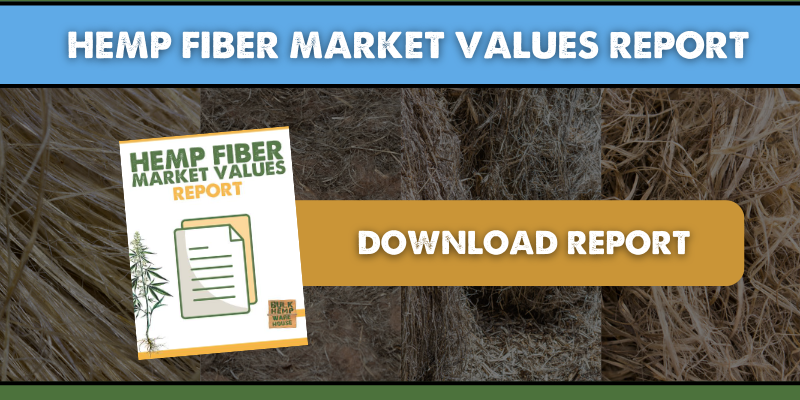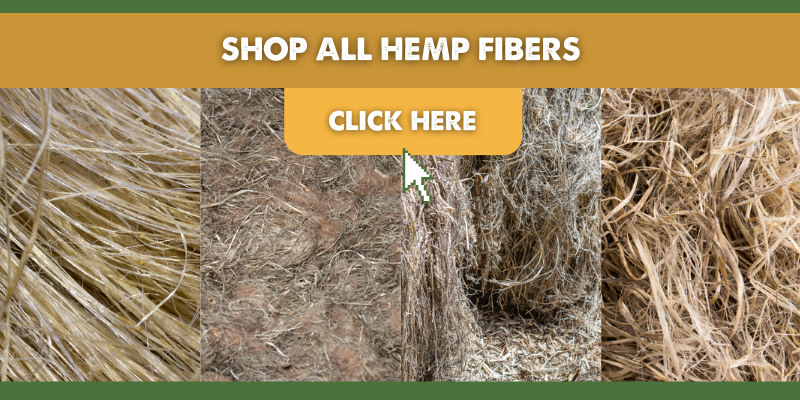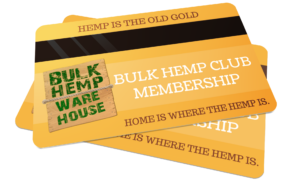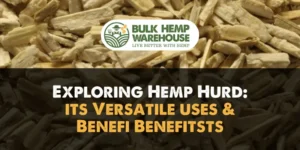

- Author Bulk Hemp Warehouse
- Categories: Hemp Benefits, Hemp Fibers, Hemp Uses
The Ultimate Guide to Hemp Fibers: Benefits, Uses & More!
Hemp fiber has been used for centuries to make many types of products, including textiles, clothing, yarn, twine, rope, building material, paper, and even dynamite!
Hemp fiber is known for its strength, durability, and versatility, and is also environmentally friendly as it requires minimal water and pesticide input in order to grow well.
In recent years, there has been a resurgence in the use of hemp fiber due to its environmental and economic benefits, which you’ll learn more about in this article.
We will cover a little bit of the history of fiber made from hemp, then go into the most common uses, and then we will help you better understand the economic potential and market value of hemp fiber.
Table of Contents

A Brief History of Hemp Fibers
Hemp is a plant that has been cultivated for millenia for its fibers, which are strong and versatile.
The use of hemp fibers dates back to ancient civilizations, where they were used to make clothing, rope, and other textiles.
During the Industrial Revolution, hemp was a popular source of fiber for making paper, sails, and other products.
However, the cultivation of hemp declined in the 20th century due to the rise of synthetic and tree-based fibers and the unwarranted criminalization of the hemp plant and anyone growing or using it.
In recent years, there has been a boom in the use of hemp fibers due to their environmental and economic benefits, in addition to their superior properties and benefits.
Hemp is a sustainable crop that requires minimal water and pesticides to grow successfully.
Hemp has been cultivated and used for its fibers in many countries around the world for centuries. Some countries that are well known for using hemp fibers include:
China: China is the largest producer of hemp in the world and has a long history of using hemp fibers for textiles, clothing, and other products.
India: India has a rich tradition of using hemp fibers for clothing, rope, and other textiles.
Canada: Canada is a major producer of hemp and has a thriving hemp industry that includes the production of textiles, clothing, and other products.
The Netherlands: The Netherlands has a long history of cultivating hemp and is known for its high-quality hemp fibers, which are used to make a variety of products, including textiles and clothing.
The United States: The United States is also a significant producer of hemp and has seen a resurgence in the use of hemp fibers in recent years.
France: In France, hemp was widely cultivated for centuries as a source of fiber for textiles, ropes, and other products. It was also used for medicinal purposes. The use of hemp declined in the 20th century with the advent of synthetic fibers, but it has seen a resurgence in recent years as a source of environmentally friendly products.
Germany: In Germany, hemp has been cultivated since the Middle Ages, primarily for the production of fiber for textiles, ropes, and paper. It was also used for medicinal purposes. Like in France, the use of hemp declined in the 20th century but has seen a resurgence in recent years.
Romania: In Romania, hemp has been cultivated for centuries for the production of fiber for textiles, ropes, and other products. It was also used for medicinal purposes. In the 20th century, the use of hemp declined but it has seen a resurgence in recent years as a source of environmentally friendly products.
Other countries that are known for using fiber from hemp include Ukraine, Russia, and Italy.
Essentially, hemp was widely used as a fiber source by many countries until the global ban and demonization of hemp and cannabis started in the 1930’s.

The Benefits of Hemp Fibers
Hemp Fibers have Several Environmental Benefits:
Sustainable Crop: Hemp is a sustainable crop that requires minimal water and pesticides to grow. It also has a short growing cycle, meaning it can be harvested multiple times per year, in particular parts of the world.
Carbon Sequestration: Hemp has a high carbon sequestration potential, meaning it can absorb and store large amounts of carbon dioxide from the atmosphere. This helps reduce greenhouse gas emissions and prevent damage to the world climate.
Soil Health: Hemp has a deep root system that helps improve soil health by breaking up hard soil and adding nutrients. It can also be grown as a cover crop to protect soil from erosion.
Waste Reduction: Hemp fibers can be used to make a wide range of products, which reduces the need for synthetic materials and the waste associated with their production and disposal.
Renewable Resource: Hemp is a renewable resource that can be grown year after year, making it a more sustainable, recycle-able, alternative to non-renewable resources like oil, which is used to make many synthetic fibers.
Hemp fibers have Several Potential Health Benefits:
Hypoallergenic: Hemp fibers are hypoallergenic, meaning they are less likely to cause an allergic reaction. This makes them a good choice for people with sensitive skin or allergies.
Breathable: Hemp fibers are breathable, which means they allow air to circulate and can help regulate body temperature. This makes them a good choice for clothing and bedding.
Antimicrobial: Hemp fibers have antimicrobial properties, which means they can help reduce the growth of bacteria and other microorganisms. This can help prevent the spread of infection and improve hygiene.
UV protection: Hemp fibers have a natural ability to block UV rays, which can help protect the skin from sun damage. This makes them a good choice for clothing and other products that are exposed to the sun.
Chemical-free: Hemp fibers are naturally chemical-free, meaning they are not treated with chemicals during the production process. This makes them a safer and more environmentally friendly choice compared to synthetic fibers, which are often treated with chemicals.
Hemp fibers have several functional & mechanical benefits:
Strength: Hemp fibers are strong and durable, making them suitable for a wide range of applications.
Versatility: Hemp fibers can be used to make a variety of products, including textiles, clothing, rope, paper, and building materials.
Absorbency: Hemp fibers have a high absorbency rate, meaning they can absorb moisture and release it quickly. This makes them a good choice for clothing and other products that may come into contact with moisture.
Insulation: Hemp fibers have good insulation properties, meaning they can help keep you warm in cold weather and cool in hot weather.
Fire & Mold Resistant: When using hemp with lime for building materials such as hempcrete, this material essentially become resistant to mold, pests and is nearly fire resistant. It’s also been shown that hemp fabrics are more resistant told mildew and mold compared to synthetic and cotton based fabrics.
Dimensional Stability: Hemp fibers have good dimensional stability, meaning they are resistant to shrinkage and stretching. This makes them a good choice for products that need to maintain their shape and size.
Softness: Hemp fibers are soft and comfortable to the touch, making them a good choice for clothing and other products that come into contact with the skin.
Biodegradable: Hemp fibers are biodegradable, meaning they can break down naturally and return to the environment. This makes them a more sustainable alternative to synthetic fibers, which can take hundreds of years to break down.

Most Common Uses for Hemp Fibers
Overall, hemp bast fibers are a versatile and sustainable plant resource that can be used to make a huge range of woven and non-woven type products.
Hemp fibers have a wide range of uses, including:
Textiles and Clothing: Hemp fibers can be used to make clothing, including t-shirts, pants, dresses, and more. They are also used to make bedding, towels, and other household textiles.
Building Materials: Hemp fibers can be used to make building materials, such as insulation, flooring, and panels. Hemp-based building materials are durable, environmentally friendly, and have good insulation properties.
Paper Products: Hemp fibers can be used to make paper products, such as books, envelopes, and business cards. Hemp paper is more durable and eco-friendly than traditional paper made from trees. And it’s been shown to be much more recyclable than tree-based papers.
Other Products: Hemp fibers can also be used to make a variety of other products, including bags, ropes, netting, and more.
Animal Bedding for small medium and large animals and pets can use hemp hurd fibers for a safe and healthy bedding.
Hemp fibers are known for their strength, durability, and versatility, and can be used to make a wide range of products.
They are also environmentally friendly and sustainable, making them a popular choice for many applications.

The Economic Value of Hemp Fiber
Hemp fibers have significant economic value, both for the farmers who cultivate them and for the industries that use them to make various products.
For farmers, hemp can be a profitable crop as it requires minimal inputs (such as water and pesticides) and has a short growing cycle, meaning it can be harvested multiple times per year.
Hemp is also a versatile crop that can be used to make a wide range of products, including textiles, clothing, building materials, and more.
For industries that use fiber from hemp, the economic value lies in their strength, durability, and versatility.
Hemp fibers can be used to make a wide range of products, including textiles, clothing, building materials, and paper products. These products are in high demand and can be sold at a profit.
In addition to the economic value of hemp fibers, there is also the potential for economic growth in the hemp industry as a whole.
As more and more people and businesses become aware of the environmental and economic benefits of hemp fibers, the demand for hemp-based products is likely to increase, leading to growth in the industry.
Overall, hemp fibers have significant economic value for farmers and industries, as well as the potential for economic growth in the hemp industry as a whole.

The Potential of Hemp Fibers in many Industries
There is significant potential for hemp fibers to play a larger role in various industries, due to their environmental, economic, and functional benefits.
In the textiles and clothing industry, hemp fibers could be used as a sustainable alternative to synthetic fibers, which are often derived from non-renewable resources like oil and have a negative impact on the environment.
Hemp fibers are naturally chemical-free and biodegradable, making them a more sustainable choice.
In the building and construction industry, hemp fibers could be used to make a variety of building materials, such as insulation, flooring, and panels.
Hemp-based building materials are environmentally friendly, durable, and have good insulation properties, making them a good choice for sustainable construction projects.
In the paper industry, hemp fibers could be used to make a variety of paper products, such as books, envelopes, and business cards.
Hemp paper is more durable and eco-friendly than traditional paper made from trees and could be used as a sustainable alternative.
Overall, the potential for hemp fibers to play a larger role in various industries is significant, as they offer a sustainable and versatile alternative to traditional materials.
As more and more people and businesses become aware of the environmental and economic benefits of hemp fibers, their use is likely to increase in the coming years.
Common Questions About Hemp Fibers

Hemp fibers are the strong, durable, and versatile fibers that are obtained from the hemp plant. They are used to make a wide range of products, including textiles, clothing, ropes, paper, and animal bedding and building materials.
Hemp fibers have several environmental benefits, including being a sustainable crop that requires minimal water and virtually no pesticides to grow, having a high carbon sequestration potential, improving soil health, reducing waste, and being a renewable resource.
Hemp fibers have several health benefits, including being hypoallergenic, breathable, antimicrobial, providing UV protection, and being chemical-free.
Hemp fibers have several functional and mechanical benefits, including being strong and durable, versatile, absorbent, insulating, having good dimensional stability, being soft, and being biodegradable.
The most common uses for hemp fiber products include textiles and clothing, building materials, paper products, and a variety of other products.a
Hemp hurd fibers are the short, woody fibers that are obtained from the inner part (or “hurd”) of the hemp plant’s stems.
They are known for their absorbent and insulating properties, and are used to make a wide range of products, including:
Hemp bast fibers are the long, strong fibers that are obtained from the outer part (or “bast”) of the hemp plant’s stems.
They are known for their strength, durability, and versatility, and are used to make a wide range of products, including:
This is a wonderful report that should provide you with enough information on how to increase optimization of hemp fiber production for composite applications.
https://www.ncbi.nlm.nih.gov/pmc/articles/PMC6265480/
Hemp is a natural fiber so the environmental benefit vs synthetics fibers is pretty obvious. But how does hemp compare to synthetic fibers as far as strength and durability? There is still a lot of research that could be done on this, but here is a great resource that will help you better understand the difference of hemp fibers vs synthetic fibers.
The degumming process for hemp fibers is typically done with potassium hydroxide which strips the lignans from the out bast fiber. Then the fibers are boiled in water to clean them and prepare for whichever application they will be used for.
Hemp fibers have significant economic value for farmers and industries, as well as the potential for economic growth in the hemp industry as a whole.
It is legal to grow and use hemp fibers in many countries around the world, although there may be restrictions in some places.
Naturally we are going to share with you what we believe are the some of the best hemp fiber products on the market here on BulkHempWarehouse.com.
To browse all our hemp fiber products click here.
To browse all the bast hemp fibers we offer click here.
To see all the hemp hurd fiber products you’ll find those here.
Hemp hurd fiber and bast fiber are both derived from the hemp plant, but they come from different parts of the plant and have different characteristics.
Bast fiber is found in the outer layer of the hemp plant’s stem, and it is long, strong, and flexible. These fibers are ideal for use in textiles and other applications that require durability and strength, such as clothing, bags, ropes, and building materials.
Hurd fiber, on the other hand, is found in the inner core of the hemp plant’s stem. It is shorter and coarser than bast fiber and is often used as a substitute for wood in the production of paper, insulation, and other building materials.
Hurd fiber is also used in the production of animal bedding and as a soil amendment in agriculture.
In terms of their physical properties, bast fibers are generally stronger and more durable than hurd fibers. They are also more flexible and have a higher tensile strength, making them ideal for use in applications that require these properties.
Hurd fibers, on the other hand, are more absorbent and softer than bast fibers, making them better suited for use in applications such as animal bedding or soil amendment.
Overall, the main difference between hemp hurd fiber and bast fiber is their origin and physical properties.
Bast fiber is found in the outer layer of the hemp plant’s stem and is strong, flexible, and durable, while hurd fiber is found in the inner core of the stem and is softer, more absorbent, and less durable.
Both fibers have a wide range of uses and are an important part of the hemp industry.
If you are looking for Hemp Fiber Price Per Ton or by the kilo or pound, checkout this free hemp fiber market report here.
Ultimate Guide to Hemp Fibers Conclusion
We hope you’ve gotten a lot out of this Ultimate Guide to Hemp Fibers, as we aim to support you on your journey to being more sustainable, and living in harmony with nature through the use of HEMP!
If you benefited from this post, we’d love for you to share it with your community and anyone you think would benefit from it as well.
If you feel we left any important information out about hemp fibers, or if you have a question we could add to the common questions section feel free to reach out and let us know your thoughts!
We look forward to seeing what YOU are doing with hemp fibers, and how you’re making the world a better place with hemp.
OTHER EDUCATIONAL HEMP POSTS
Explore Other Posts by Bulk Hemp Warehouse
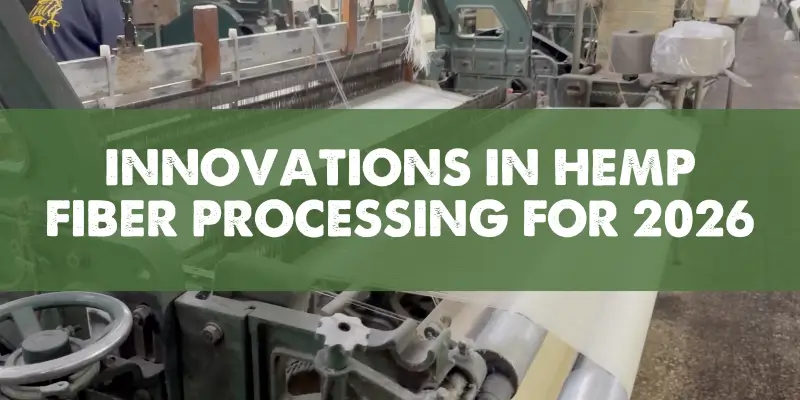
Innovations in Hemp Fiber Processing for 2026
Hemp fiber processing has undergone significant advancements in recent years, paving the way for more efficient and sustainable practices and bringing it back home to the USA once again. As industrial hemp production continues to grow, the demand for high-quality

Why Hemp Seeds Are the Ultimate Superfood for Birds – And Why Corn, Wheat, and Soy Don’t Belong in Their Diet
Could hemp seeds be the NEW Bird Feed that beats corn wheat and soy? I think so.
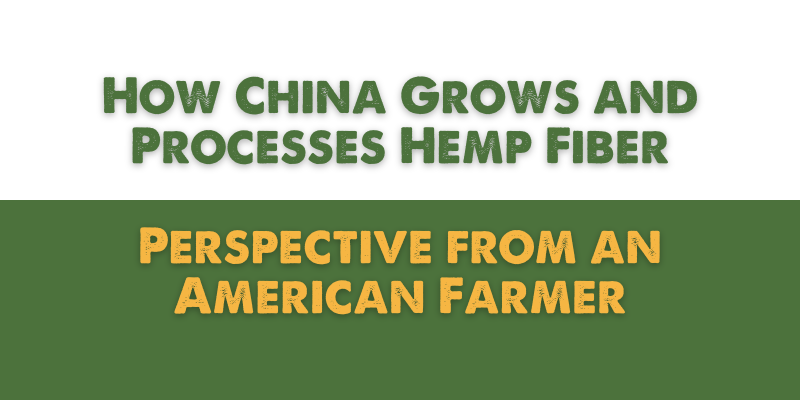
How China Grows and Processes Hemp Fiber – From an American Farmer
Steve Groff, a third-generation farmer from Southeastern Pennsylvania, recently embarked on a transformative journey to China, a trip that has profoundly impacted his perspective on the future of hemp farming and textile production. This wasn’t a casual tourist visit; it


